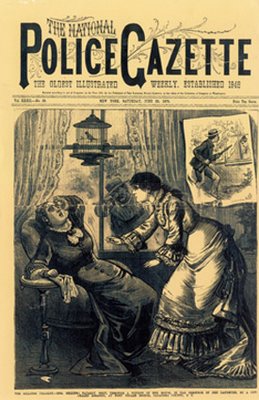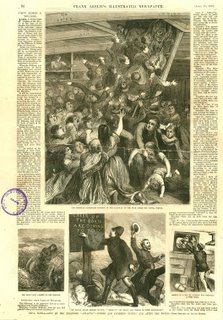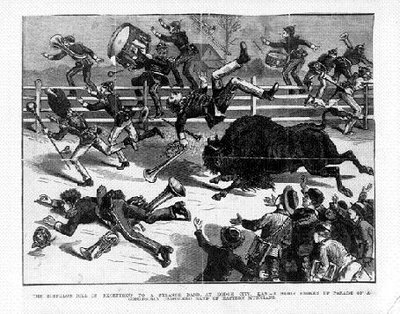 It's hard to believe but newspapers in the late 1800s were more attractive in one respect than papers are now. The biggest difference is that old newspapers relied mostly on pictures that were drawn.
It's hard to believe but newspapers in the late 1800s were more attractive in one respect than papers are now. The biggest difference is that old newspapers relied mostly on pictures that were drawn.  An artist can draw a news event, say a murder, in the most exciting way possible. He'll show you the shooter (top picture, above) sneaking up to the victim's home and taking a bead on her. A photographer can't do that. He's stuck with showing up the next day and taking taking a picture of an empty house surrounded by yellow police tape.
An artist can draw a news event, say a murder, in the most exciting way possible. He'll show you the shooter (top picture, above) sneaking up to the victim's home and taking a bead on her. A photographer can't do that. He's stuck with showing up the next day and taking taking a picture of an empty house surrounded by yellow police tape.Even televised news is at a disadvantage compared to artist-rendered print media. How would the TV news cover an event like the one shown below where a buffalo went on the rampage? If the cameraman didn't happen to be there all he can do is photograph witnesses talking about it.

We all know that print media is eventually going to lose out to digital media but, given it's magnificent history, it should go down swinging, using every asset at its command. It should tell the news with both art and photography.
BTW, my sources for these pictures, The Police Gazzette and Frank Leslie's ,were weeklies and had a bigger budget for drawings than did dailies of the time.

21 comments:
i agree with you fitzgerald. just like the modern photojournalist's pictures are his/her own view points the illustrator for the scenarios could also give their own view, and make it exciting to look at. i would buy newpapers if they had more cool black and white illustrations instead of reading news on the intarnets.
but, i do believe that certain photojournalism is very important. say... pictures of the devestation of war, these images, however sensationally illustrated, could not strike the veiwer so deeply as a real photograph of real situations.
also as long as "time=money" and "cash rules everything around me" the editors will continue to give the jobs to photographers rather than illustrators, or 'drawers', you know. now, fantastic drawings in a tabloid.... that would be some fun! i would love to illustrate their hair-brained stories.
p.s. P.Bagge has a great running strip in Weekly World News (i think) about the "bat boy" character.
Great post. A few months back actually I saved a stunning piece of what seems to be newspaper art. Check out the scene's action and how the man being choke leaps off the page in full dark ink compared to the gray of the crowd. Only one shadow being cast in the picture.
http://img85.imageshack.us/img85/2482/18640227discussion280hp6.jpg
It's one of the most 3-dimensional pieces of art I've seen. That alone configures my opinion on newspaper art's value. Very exciting, very bold, and far more interesting.
but, i do believe that certain photojournalism is very important. say... pictures of the devestation of war, these images, however sensationally illustrated, could not strike the veiwer so deeply as a real photograph of real situations.
True. The ideal paper would be a mix of both. Painting the picture in more than one medium so to speak.
Brilliant as usual Uncle Eddie!
Thanks for educating me on the history of printed news. I had no idea. (But it makes perfect sense.)
You really should hie yourself to the Pasadena Library and look at the 100 year old LA and NY(and Pasadena)papers; I've done that since high school if there's any event I'm interested in or just for the heck of it. The writing not only wasn't bad, it wasn't nearly as antiquated as we'd imagine from what pop culture today suggests. And the art is everywhere and phenomenal. Here's a typical one:WW1. There's also a great book called "The World on Sunday" you would love to leaf through.
As for everday illustrations, the only thing we have now are courtroom drawings, and for some reason they're uniformly weak--at least the ones I've seen. ALL these people do is draw the human face and body, yet it seems most have a very hard time doing anything that looks natural or even resembles the subject.
Too bad the newspaper business is not healthy enough financially to consider this a good idea. And you see what they think of cartoonists already... look at the funnies, or the continuingly shrinking pool of editorial cartoonists (and the general effect on draftmanship in general this attitude has produced)
Back when Citizen Hearst and the like would pay the illustrators, thinking most of the populace couldn't read anyway (They were probably more literate then than now), Media had this silly notion that the end consumer was who they were producing the product for.
Of course TV, Radio and Newspaper know who their client is now... the advertisers.
They haven't made the connection about lost readers and lower circulation... They only count and quantify those they hang on to, not the multitudes they have lost.
As for everday illustrations, the only thing we have now are courtroom drawings, and for some reason they're uniformly weak
On a related note - I once saw a retail caricaturist hired to do a courtroom scene - and (although unintentional, I'm sure) they proceded to give everyone the 'big head, little body' treatment.
Old habits, I suppose. :)
– Corbett
Unfortunatly, technology will continue to advance and take away all of our highly skilled arts.
I worked at a newspaper for awhile and before the advent of photoshop and page layout programs, The layout department had to create metal plates for each page, with all the type and images backwards. This was daily! These metal plates were huge and heavy. Then the news still had to be sent to the printer. These plates were then melted down and set for the next day.
This whole process can now be done in minutes.
Great pictures. While a photojournalist does quite well in his work, there's nothing like an in-the-moment illustration that goes to the scenes the camera could not.
Yes! Those were the good 'ol days when they could get away with exaggerating horror and crime to sell papers, instead of considering the murderer's "feelings".
Plus, they had the Yellow Kid back then. Gotta love the Yellow Kid!
I particularly enjoyed this theory, Eddie. It would be great to have illustrated news stories in the papers again, even if it was just a couple here and there (maybe the stories with no photgraphable evidence). And boy, those illustrations make you think you're right there seeing the whole thing!
I'm reading a book on American Folklore right now, and it talks about folk ballads being used to relate the story of traumatic news events (like the Wreck of the Old 97). In England, they had what were called "broadsides", which were satirical or melodramatic commentary on current events set to the tune of a popular song.
If only Dan Rather could sing!
See ya
Steve
I think there's a danger in using illustartion as opposed to photography. Newspapers are supposed to offer unbiased views ("supposed to" being the operative phrase) and illustrations are interpretations of events and can therefore never be unbiased. While photographs can be and are used to manipulate a reader, they can also be less prone to interpretation because, when unmanipulated, they are an actual moment of the event at hand.
While drawings are certainly more fun to look at, that doesn't mena they are always the best medium to represent something.
All of that being said, I think that your blog is one of the best things on the internet. Thanks!
Hey Eddie!
I've really enjoyed reading your blog. Especially the stuff about grotesqueness, and the caricatures done of you.
Not to be annoying! -
I made a short film about a bad cartoonist that I want all my cartoon heroes to see, especially you and others who were at Spumco! It's about a daily newspaper strip and the hype surrounding it. But its also about mediocrity in art and how it's become the norm these days. And its about lots of other things to. It's mainly a character study.
It's the first post in my blog (that I just created), if you want to check it out!
And yes, I'm amazed by how old newspapers looked. They were works of art!! I don't even think the news SHOULD be works of art, but they look wonderful and striking.
-Jordan
Generally speaking, illustrations in daily newspapers were rare until about the 1880s or so. If you read "Thomas Nast: His Period and His Pictures" you'll find out why: the process for creating engravings from drawings was a very slow and tedious one, requiring a great deal of work not only from the artist, but the engraver, especially for woodblock engravings, like Nast's Civil War stuff. (If you look at a lot of Tenniel's cartoons for Punch, you'll find the name of the engraver on the cartoon, too.)
This was why most editorial cartoons through the 1880s came via the weekly newspapers, Harper's Weekly being the most prominent. It was only with the development of photoengraving that the daily political cartoon (and, for that matter, the comic strip) came to the fore.
What's remarkable is that the quality of daily political cartoons was fairly poor, on the whole, clear up to World War I, when some of the better artists (John Knott, Oscar Cesare, Dan Fitzpatrick, Jay Darling, et alia) finally began to get a grip on the new media, and lead the way. F.P. Opper, the creator of the Happy Hooligan, occasionally dabbled in editorial cartoons, and he (and maybe John McCutcheon, now that I think of it) are perhaps exceptions to the daily political cartoons of the Yellow Kid era.
Mantoe, Jordan, Jenny: I sampled Bagge's comic strip and Jordan's film (Jordan's 30+ minute film...it's too long!) I also looked at the book Jenny recommended...very interesting! I'll write more about it later. BTW, Jenny,I really like your blog, "Blackwing Diaries."
its long! i admit it! i didn't have enough time at school to edit it and plan on cutting it down soon (with the help of a good friend with a mac)! But there's lotsa good stuff there and we packed it with so many details, jokes, ideas. The original cut was an hour and 15 minutes! I literally cried while I was editing it! Really! It was so challenging.
ANYWAY -- Thanks for checking it out! I'd be interested in any "theorizing" about it!!
Very grateful,
-Jordan
Eric: I looked up the names you mentioned and was impressed. Well, maybe a little less so with Fitzpatrick who had a gift for dramatic values but seemed to have a problem with composition. Jay Darling was terrific!
The engravers of the late 1800s were incredible! It must have been a stressful job.
Anonymous: Good point about the papers trying to please the advertisers instead of the customers!
The Ding Darling Foundation has, from time to time, sold CDs containing all of Darling's editorial cartoons, searchable by topic. (The foundation supports wildlife refuges: Darling was, amazingly enough, chief of the Wildlife Service during the 30s, and designed the first duck hunting stamps -- he was in the Gifford Pinchot school of conservation long before it became cool.)
Contemporary Darling cartoon books exist: I have his "Aces and Kings" from 1917-1918. More available is the book "Ding's Half Century."
All of the other figures I mentioned in my original post I have books, some rather rare (like Cesare's book). For a general overview of the history of American political cartooning through 1970, I can recommend "The Ungentlemanly Art."
Eric: There's a Darling foundation!!?? Incredible!
Check it out, O Fitzgerald:
http://www.dingdarling.org/index.html
Note the entry for the CD-ROM at left.
Eric: Wow! 55 bucks for 6800 Ding Darling cartoons! That's less than a cent a cartoon! This reminds me that once the complete Mad magazine was offered on CD-rom or was it on floppy discs? In any case, a friend of mine got it on Ebay and couldn't play it
Post a Comment